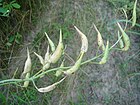Note: This is a project under development. The articles on this wiki are just being initiated and broadly incomplete. You can Help creating new pages.
Raphanus sativus - Mulaka
Mulaka is a plant in the mustard family cultivated throughtout the world for its pungent edible roots.
Contents
- 1 Uses
- 2 Parts Used
- 3 Chemical Composition
- 4 Common names
- 5 Properties
- 6 Habit
- 7 Identification
- 8 List of Ayurvedic medicine in which the herb is used
- 9 Where to get the saplings
- 10 Mode of Propagation
- 11 How to plant/cultivate
- 12 Commonly seen growing in areas
- 13 Photo Gallery
- 14 References
- 15 External Links
Uses
Hemmarhoids, Burning sensation, Eye disorders, Cough.[1]
Parts Used
Chemical Composition
Common names
| Language | Common name |
|---|---|
| Kannada | Moolangi, |
| Hindi | Mooli |
| Malayalam | Kankapal, Mullangi |
| Tamil | Mullangi |
| Telugu | Mullangi |
| Marathi | NA |
| Gujarathi | NA |
| Punjabi | NA |
| Kashmiri | NA |
| Sanskrit | Mulaka, Mulakam, Muli, Mulika |
| English | Radish |
Properties
Reference: Dravya - Substance, Rasa - Taste, Guna - Qualities, Veerya - Potency, Vipaka - Post-digesion effect, Karma - Pharmacological activity, Prabhava - Therepeutics.
Dravya
Rasa
Tikta (Bitter), Katu (Pungent)
Guna
Laghu (Light)
Veerya
Sheeta (cold)
Vipaka
Katu (Pungent)
Karma
Pitta, Vata, Kapha
Prabhava
Habit
Identification
Leaf
| Kind | Shape | Feature |
|---|---|---|
| Lyrate | Alternate | Lower leaves lyrate-pinnatifid, ovate-oblong in general outline, long-stalked, 3-5-jugate, terminal lobes suborbicular, rounded at apex, crenate along margins. |
Flower
| Type | Size | Color and composition | Stamen | More information |
|---|---|---|---|---|
| Bisexual | Racemes | White/pink | Racemes many flowered, up to 40 cm long in fruit. pedicels 1-2 cm long in fruit. |
Fruit
| Type | Size | Mass | Appearance | Seeds | More information |
|---|---|---|---|---|---|
| Siliqua | 2-6 x 0.4-0.5 cm | Beak conical, seedless, 1-2 cm long; valves spongy, scarsely ribbed, often obscurely constricted between seeds | {{{5}}} | {{{6}}} |
Other features
List of Ayurvedic medicine in which the herb is used
Where to get the saplings
Mode of Propagation
How to plant/cultivate
Seed - sow in situ in succession. Germination takes place within a few days of sowing the seed. If you want a constant supply of the roots then you need to sow seed every 2 - 3 weeks. [5]
Commonly seen growing in areas
Tropical area, Sub Tropical area
Photo Gallery
References
- ↑ Uses
- ↑ Vernacular names
- ↑ [Leaf info]
- ↑ Ayurvedic preparations
- ↑ Cultivation details
External Links
- Ayurvedic Herbs known to be helpful to treat Hemmarhoids
- Ayurvedic Herbs known to be helpful to treat Burning sensation
- Ayurvedic Herbs known to be helpful to treat Eye disorders
- Ayurvedic Herbs known to be helpful to treat Cough
- Herbs with Flowers used in medicine
- Herbs with Leaves used in medicine
- Herbs with Roots used in medicine
- Herbs with common name in Kannada
- Herbs with common name in Hindi
- Herbs with common name in Malayalam
- Herbs with common name in Tamil
- Herbs with common name in Telugu
- Herbs with common name in Sanskrit
- Herbs with common name in English
- Habit - Herb
- Index of Plants which can be propagated by Seeds
- Herbs that are commonly seen in the region of Tropical area
- Herbs that are commonly seen in the region of Sub Tropical area
- Herbs
- Ayurvedic herbs that don't have seed photos
- Brassicaceae





